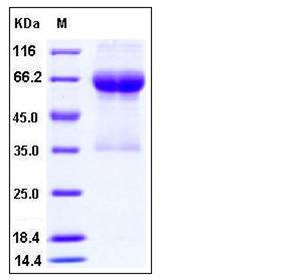Mouse PD1 / PDCD1 Protein (His & Fc Tag)
Ly101,PD-1,Pdc1
- 100ug (NPP3438) Please inquiry
| Catalog Number | P50124-M03H |
|---|---|
| Organism Species | Mouse |
| Host | Human Cells |
| Synonyms | Ly101,PD-1,Pdc1 |
| Molecular Weight | The recombinant mouse PDCD1/Fc chimera is a disulfide-linked homodimeric protein. The reduced monomer consists of 391 amino acids and has a predicted molecular mass of 44.2 kDa. In SDS-PAGE under reducing conditions, the apparent molecular mass of rm PDCD1/Fc monomer is approximately 60-65 kDa due to glycosylation. |
| predicted N | Leu 25 |
| SDS-PAGE |  |
| Purity | > 90 % as determined by SDS-PAGE, with approximately 10 % free Fc frag |
| Protein Construction | A DNA sequence encoding the extracellular domain (Met 1-Gln 167) of mouse PDCD1 (NP_032824.1) was fused with the C-terminal polyhistidine-tagged Fc region of human IgG1 at the C-terminus. |
| Bio-activity | Measured by its binding ability in a functional ELISA . Immobilized recombinant mouse PD1-L1 at 1 μg/ml (100 μl/well) can bind mouse PD1 with a linear range of 6.25-400 ng/ml . |
| Research Area | Signaling |Signal Transduction |ITIM/ITAM Immunoreceptors and Related Molecules |
| Formulation | Lyophilized from sterile PBS, pH 7.4 1. Normally 5 % - 8 % trehalose and mannitol are added as protectants before lyophilization. Specific concentrations are included in the hardcopy of COA. |
| Background | Programmed cell death 1, also known as PDCD1, is a type I transmembrane glycoprotein, and is an immunoreceptor belonging to the CD28/CTLA-4 family negatively regulates antigen receptor signaling by recruiting protein tyrosine phosphatase, SHP-2 upon interacting with either of two ligands, PD-L1 or PD-L2. PD1 inhibits the T-cell proliferation and production of related cytokines including IL-1, IL-4, IL-10 and IFN-γ by suppressing the activation and transduction of PI3K/AKT pathway. In addition, coligation of PD1 inhibits BCR-mediating signal by dephosphorylating key signal transducer. PD1 has been suggested to be involved in lymphocyte clonal selection and peripheral tolerance, and thus contributes to the prevention of autoimmune diseases. Furthermore, PD1 is shown to be a regulator of virus-specific CD8+ T cell survival in HIV infection. As a cell surface molecule, PDCD1 regulates the adaptive immune response. Engagement of PD-1 by its ligands PD-L1 or PD-L2 transduces a signal that inhibits T-cell proliferation, cytokine production, and cytolytic function. |
| Reference |
